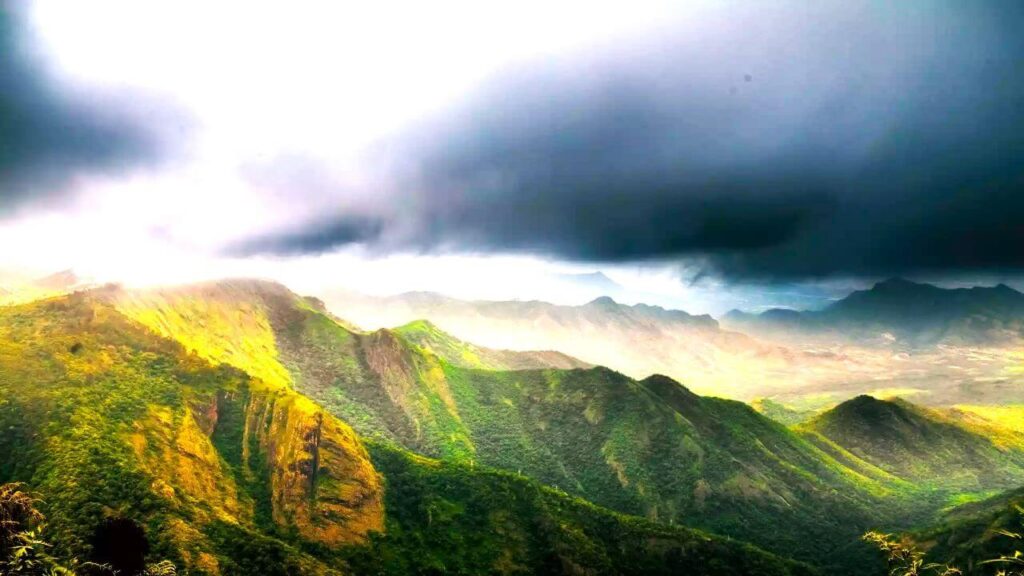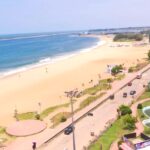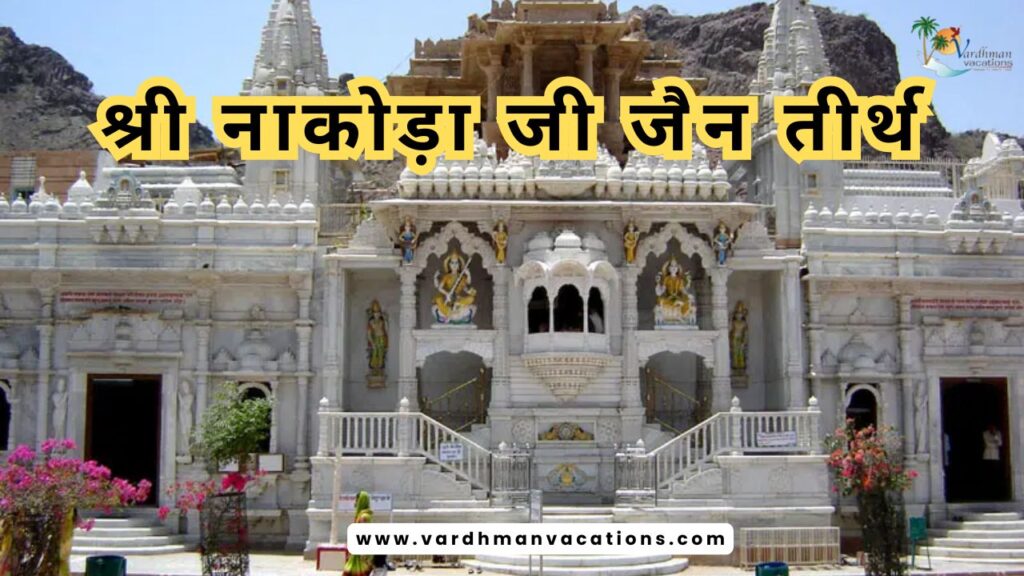Kodaikanal, established in 1845 by American missionaries and British civil servants, served as a summer retreat to escape the heat and humid summers of the plains. It was a popular vacation spot for the British during the colonial era and later became a renowned hill station for the British Raj. Even after Indian independence, it remained a favored tourist destination.
Often referred to as the “Princess of Hill Stations,” Kodaikanal is a picturesque town nestled in the Western Ghats of Tamil Nadu, India. It is known for its cool climate, lush green valleys, mist-covered cliffs, and serene lakes. Key attractions include the star-shaped Kodaikanal Lake, Bryant Park, Coaker’s Walk, and the Pillar Rocks. The town’s rich biodiversity, featuring the unique Kurinji flower that blooms once every twelve years, adds to its charm. Kodaikanal is a popular destination for nature lovers and offers various outdoor activities such as boating, trekking, and cycling, making it a perfect retreat from urban life.
Tourist Attractions in Kodaikanal
Kodaikanal, often referred to as the “Princess of Hill Stations,” is known for its natural beauty and serene environment. Here are some of the most important attractions in Kodaikanal:
Coakers walk
Timings: 09.00 AM to 05.00 PM
Entrance fee: Rs.30
Camera fee: Rs.50
Video camera fee: Rs.100
Coaker’s Walk is a one-kilometer-long walking trail situated on the highlands of Kodaikanal. It was built by Lieutenant Coaker in 1872 and is named after him. The trail offers stunning panoramic views of the Pambar River Valley, the plains below, and even Madurai in the distance on clear days. It starts at Van Allen Hospital and connects to the main road above St. Peter’s Church.
For safety, the pathway has fencing and a drop on one side. Surrounded by rich foliage, it provides spectacular views of the valley, hills, and mountains. It’s even possible to see clouds below, giving the impression of walking in the air. Kodaikanal’s cool and refreshing weather makes Coaker’s Walk suitable for a stroll at any time of year. Along the walkway, there is an observatory that offers tourists a more expansive and clear perspective of the countryside. The pathway is walled on both sides for safety, making it an ideal location for families with young children.
Bryant Park
Timings: 09.00 AM to 05.00 PM
Entrance fee: Rs.30 for adults & Rs.15 for child
Camera fee: Rs.50
Video Camera fee: Rs.100
Bryant Park, located in Kodaikanal, is a beautiful botanical park that was established in 1908 by H. D. Bryant, a forest officer from Madurai. The 20-acre park, situated on the eastern side of Kodai Lake, boasts approximately 325 different types of trees, shrubs, cacti, and flowers. It is a paradise for nature enthusiasts, featuring a diverse collection of flora from around the world. Within the park, you’ll find flowering plants, towering trees, delicate flowers, and fascinating cacti. Notably, there is a 157-year-old eucalyptus tree from India’s first war of independence. The park is particularly stunning during the summer months when the flowers are in full bloom, displaying a vibrant array of colors.
Furthermore, the park hosts an annual flower festival in May, showcasing the region’s exquisite flowers and decorative plants, with over 85 types on display. Additionally, the park is home to a greenhouse with an assortment of exotic flowers, ferns, and ornamental plants from various parts of the world. Bryant Park serves as a practical teaching center for ornamental horticulture and a student demonstration facility, offering a tranquil retreat amidst the serene beauty of nature. Families will find it to be an excellent destination, with walking paths, a children’s play area, and ample space for relaxation. The park’s peaceful ambiance and picturesque surroundings make it perfect for a picnic lunch or a leisurely stroll.
Dolphin Nose
Timings: 09.00 AM to 05.00 PM
Entrance fee: No
Camera fee: Nil
Video Camera fee: Nil
The Dolphin’s Nose in Kodaikanal is a famous viewpoint known for a rock formation that looks like a dolphin’s nose. It is 6,600 feet high and offers beautiful views of the Palani Hills’ green valleys, waterfalls, and distant mountains. To reach Dolphin’s Nose, you can take a scenic 3-kilometer walk through the pine forests and rocky terrains of the Palani Hills. The walk itself is beautiful, and the viewpoint provides a stunning panoramic view. You might even find a hidden waterfall or a small village along the way. The viewpoint offers some of the most breathtaking panoramic views of Kodaikanal, with cascading waterfalls and lush green valleys. The main attraction of Dolphin’s Nose is undoubtedly the amazing view it offers of the Palani Hills’ hills, valleys, and waterfalls. The hike to Dolphin’s Nose is moderate and suitable for most fitness levels. The trail is well-maintained and gives you a chance to enjoy the beauty of the Palani Hills. The entire route to Dolphin’s Nose is surrounded by lush flora, making the journey delightful. You might also spot some unique birds and wildlife along the way. The viewpoint is perfect for photographers, offering numerous opportunities to capture stunning images of the landscapes and natural beauty.
Green Valley View
Timings: 09.00 AM to 05.00 PM
Entrance fee: No
Camera fee: Nil
Video Camera fee: Nil
Green Valley View, formerly known as Suicide Point, is a viewpoint in Kodaikanal that offers a stunning view of the plains, deep valleys, and hills below, with the Vaigai Dam as the focal point. It’s important to be cautious and stay within the designated boundaries for your safety. The valley below the viewpoint has a 5000-foot drop, which explains its previous name. Fortunately, safety measures have been put in place, such as railings, making it a safe spot for tourists to enjoy the magnificent scenery. The viewpoint is easily accessible by road and is approximately 5.5 kilometers from Kodaikanal Lake. It’s a great place to enjoy the outdoors throughout the year, as Kodaikanal is known for its cool and invigorating weather. The viewpoint is well-maintained and has safety railings in place.
Kodai Lake
Timings: 09.00 AM to 05.00 PM
Entrance fee: No
Camera fee: Nil
Video Camera fee: Nil
Kodai Lake is a beautiful man-made star-shaped lake in Kodaikanal, surrounded by hills. It was built in 1863 by Sir Vere Henry Levinge, the collector of Madurai. It’s a popular tourist spot and is considered the gem of Kodaikanal. The lake covers 60 acres and is 9.8 feet deep on average. The star shape of the lake adds to its visual appeal and it is easily recognizable due to its central location in town. The lake is surrounded by green hills from the Palani Hills range, which provide a peaceful atmosphere. You can take a 5-kilometer walk around the lake on a paved path, enjoying the fresh mountain air and the scenic beauty. Kodai Lake played a crucial role in the history and development of Kodaikanal and was influential in attracting British residents and missionaries to the area. The star-shaped lake with its lush greenery and misty hills creates an ideal backdrop for photography.
Pillar Rock
Timings: 09.00 AM to 05.00 PM
Entrance fee: Rs.20
Camera fee: Rs.50
Video Camera fee: Rs.100
Pillar Rock is about 5 miles from Kodaikanal Lake. It consists of three large granite rock formations standing together, reaching heights of up to 400 feet. This natural wonder is a popular tourist attraction in Kodaikanal. The space between the rocks is called the Devil’s Kitchen and is a favorite spot for photos. The rocks are a result of millions of years of weathering, offering stunning views of the hills and valleys. The small garden by the rocks is great for a picnic or a leisurely walk. Pillar Rock is a favorite for photographers due to its unique rock formations and lush plants.
Moir Point
Timings: 09.00 AM to 05.00 PM
Entrance fee: Rs.20
Camera fee: Rs.50
Video Camera fee: Rs.100
Moir Point is about 10 kilometers from Kodaikanal Bus Stand and around 3 kilometers from Pillar Rock. It’s a great place to see the valleys and mountains. The spot is named after Sir Thomas Moir, who started building the Goschen Road in 1929. This road leads to the beautiful Berijam Lake in Kodaikanal. You can see a monument honoring Sir Thomas Moir’s work when the road meets the Kodaikanal-Berijam Lake road. The best part of Moir Point is the stunning view of hills, valleys, and mountains. It’s also the starting point of the Goschen route, an important road built in the early 1900s. Moir Point is a peaceful place away from the busy Kodaikanal town. You can relax and enjoy the beautiful surroundings and fresh mountain air there.
Devil Kitchen or Guna Caves
The Devil’s Kitchen is located around 8 kilometers from Kodaikanal Lake, near Pillar Rock. It is a group of natural caves that were discovered by a British officer named B.S. Ward in 1821. These caves are now closed to the public due to safety reasons, as there have been instances of people going missing and difficulties in recovering their bodies. Originally named because of the large number of bat colonies in the dark caves, the Devil’s Kitchen refers to the gap between two major pillars of the Pillar Rock formations. This gap provides a stunning view and is popular among photographers. While not exactly caverns, the tight gap and its connection with the ancient caves help explain the name.
Please Remember: Due to safety concerns, the caves are currently off-limits to the public. Visitors can only view the caves from a distance, behind a fence. There have been stories of people disappearing after entering the caves, with no bodies recovered. Legends and mystery surround the caves, contributing to the prohibition of entry for safety reasons.
Pine Forest
Timings: 09.00 AM to 05.00 PM
Entrance fee: Rs.20
Camera fee: Rs.50
Video Camera fee: Rs.100
Take a walk through Kodaikanal’s pine forests, which were planted in 1906. These forests offer a peaceful break from the busy hill station. Enjoy the tall pine trees and cool, refreshing atmosphere. You’ll find dried pinecones and needles covering the ground, creating a unique visual and fragrant experience. The forest, located in the southwest part of Kodaikanal near Moir Point, is a serene and refreshing place with its large trees, carpeted ground, and fresh mountain air. Visitors can take leisurely walks, breathe in the fresh air, or even go for a horseback ride. Photography enthusiasts will find many opportunities to capture the beauty of the pine trees and surrounding scenery. The pine forests are open to visitors all year round, but the best weather is from March to May, while the lush vegetation during the monsoon season from June to September is also worth seeing.
Chettiar Park
Timings: 09.00 AM to 05.00 PM
Entrance fee: Rs.30
Camera fee: Rs.50
Video Camera fee: Rs.100
Chettiar Park is a small but well-maintained park located near Kurinji Temple, about 1.5 kilometers from Kodaikanal town and 3.2 kilometers from the bus stop. It’s a great place to relax and enjoy the natural beauty of Kodaikanal, surrounded by lush greenery and various flowers. The park was created in 1908 by the Chettiar Group, a wealthy society from Tamil Nadu. It features well-kept gardens with a variety of beautiful flowers, including the rare Kurinji flower that blooms once every 12 years. The park is known for its stunning display of purple Kurinji flowers when they bloom. Additionally, there’s a small play area for kids, making it a good spot for families. The park’s lovely flowerbeds and green grass offer a soothing environment to take a peaceful walk and enjoy the serenity away from the hustle and bustle of Kodaikanal.
Kurunji Andavar Temple
Timings: 07.00 AM to 07.00 PM
The Kurinji Andavar Temple also called the Kurinji Murugan Temple, is a Hindu temple located about 3 kilometers from Kodai Lake in Kodaikanal. It was built in 1936 by Lady Leelavathi Ramanathan, who was originally from Europe but embraced Hinduism after her marriage to an Indian lawyer. The temple is dedicated to Lord Murugan, the God of Hills. It is named after the Kurinji flower, which blooms in the nearby hills once every 12 years. This flower gives the temple its name. The temple is designed in the Dravidian style, with tall entrances, intricate carvings, and a peaceful atmosphere. It is a popular Hindu pilgrimage site, especially during the Tamil month of ‘Thai’ (January-February). The main deity worshipped here is Lord Murugan, also known as Kurinji Easwaran or Karuneeshwaran. Additionally, there are smaller shrines for other Hindu deities such as Ganesha, Vishnu, and the Navagrahas (the nine planets). The temple offers a serene environment where visitors can worship, meditate, or simply enjoy the calm surroundings. This temple is a symbol of religious tolerance and cultural harmony, with a combination of spiritual significance, historical importance, and natural beauty.
Shenbaganur Observatory Museum
Timings: 10.00 AM to 11.30 AM & from 03.00 PM to 05.00 PM
Entrance: Rs.20
The Shenbaganur Museum, also known as the Shenbaganur Natural History Museum, is about 5.6 kilometers from Kodaikanal Lake. The museum focuses on the natural history of the Western Ghats region, particularly the plants and animals near Kodaikanal. It has displays featuring birds, mammals, insects, butterflies, reptiles, and plants. There’s also a collection of about 2500 plant types. You can learn about the geological features and rocks in the area. The museum also has an astronomy section, with exhibits about celestial bodies, telescopes, and the history of astronomy in India. Additionally, there may be sections on anthropology and local tribal art and crafts. The museum is a valuable resource for students and tourists interested in the natural world and local history. It’s a great place to learn about the biodiversity of the Western Ghats.
Silver Cascade Falls
Silver Cascade Falls is a beautiful waterfall on the way to Kodaikanal, at a height of 2318 meters. It is located on the Ghat road, about 8 kilometers from Kodaikanal Lake. The water drops 180 feet, creating a stunning sight. The falls are believed to be caused by excess water from Kodai Lake, a man-made lake created by combining three separate lakes. The water flows down rocks, creating a cascading effect and a silver color that gave the falls their name. As the water descends the cliffs, it gathers in a pool said to have healing properties, making it a popular spot for bathing, especially during the hot summer months. The falls are beautiful all year round but are especially impressive during the rainy season (June to September) when the water flow is at its highest.
Other Interesting places around Kodaikanal
Poomparai
Poomparai is a beautiful town located 18 kilometers from Kodaikanal, in the Palani Hills. It is known for its terraced farming, a historic Murugan temple, and scenic beauty, providing a glimpse into rural life in Tamil Nadu. The terraced farming not only adds to the village’s beauty but also helps with effective irrigation and farming on mountainous terrain. The Kuzhanthai Velappar Temple, dedicated to Lord Muruga, is a significant historical landmark in Poomparai. This temple dates back to the fifth century BC and draws devotees during the Tamil calendar month of Thai or Maasi on the Kettai nakshatra. Poomparai offers a peaceful retreat from the busyness of Kodaikanal, with its fresh mountain air, serene surroundings, and relaxed pace of life. The weather in Poomparai is generally pleasant all year round.
Mannavanur
Mannavanur is a charming village located 35 kilometers west of the popular hill station Kodaikanal. This village is surrounded by beautiful natural landscapes and is known for attractions such as Mannavanur Lake and hiking paths. Mannavanur is mostly a rural community, famous for its farming. The area around the village is filled with green fields and farms, giving a glimpse of Tamil Nadu’s traditional farming life. Mannavanur Lake is the highlight of the village, popular for boating and relaxing by the shore. The lake is also known for its diverse fish population, attracting birdwatchers. Nature enthusiasts can explore the hiking trails that offer stunning views of the region. Near Mannavanur, there is a government sheep breeding and research center where visitors can learn about different sheep breeds. Mannavanur is a great choice for those seeking an adventure off the usual tourist path in Tamil Nadu, providing a chance to connect with nature, explore Mannavanur Lake, and experience rural hospitality.
Berijam Lake
Berijam Lake is a reservoir located in the upper Palani Hills, close to Kodaikanal town in Tamil Nadu’s Dindugul district. The lake, formed by a dam, is part of a micro-watershed development initiative. The water in the lake is of excellent quality. Surrounded by beautiful woodlands, Berijam Lake offers a peaceful and uncrowded atmosphere, providing a chance to enjoy nature’s beauty. The lake is home to diverse vegetation and wildlife, including crested serpent eagles, pariah kites, pale-rumped swallows, and edible nest swiftlets. Visitors may even have the opportunity to spot larger animals such as bison and leopards. Fishing enthusiasts can enjoy the outstanding fishing opportunities the lake provides, with prior permission from the fisheries department. Additionally, visitors can take a leisurely boat ride on the calm waters of the lake and soak in the beauty of the surroundings.
Please Remember: To visit Berijam Lake in Kodaikanal, you need a permit from the District Forest Office. Permits are limited and given on a first-come, first-served basis, so it’s best to arrive early. The number of cars allowed each day may be limited. Make sure to confirm entry times and other requirements right away with the Forest Department. Keep in mind that permits are subject to availability each day, and there may be cancellations. Since the number of vehicles allowed is limited, getting a permit on the day of your visit is not guaranteed. The Forest Department may cancel permits without giving prior notice.
These attractions make Kodaikanal a perfect destination for nature lovers, adventure seekers, and those looking for a peaceful retreat.
How to Reach Kodaikanal
By Air: The nearest airport to Kodaikanal is Madurai International Airport (IXM), located approximately 120 kilometers away. The airport is easily accessible from several domestic cities such as Chennai, Bangalore, Mumbai, Delhi, Hyderabad, Kolkata, Ahmedabad, and Goa, as well as from international destinations including Dubai, Singapore, and Colombo. The second nearest airport is Coimbatore International Airport (CJB), which is 200 kilometers away from Kodaikanal.
By Train: The nearest train station to Kodaikanal is Kodai Road Station (KQN), which is around 80 kilometers away. Several trains operate between Kodai Road and major cities such as Chennai, Bangalore, and Madurai.
By Road: Kodaikanal is well-connected by road to several prominent South Indian cities like Bangalore, Chennai, Coimbatore, and Madurai.
Conclusion
Kodaikanal offers a perfect blend of natural beauty, adventure, and tranquility, making it an ideal destination for travelers seeking a serene escape. Whether you’re exploring the misty hills, enjoying the cool breeze by the lake, or marveling at the stunning vistas from various viewpoints, Kodaikanal promises an unforgettable experience. Embrace the charm of this hill station, and let the peaceful ambiance rejuvenate your soul, leaving you with memories that will last a lifetime.







